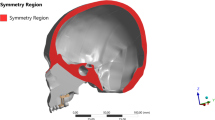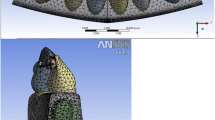Abstract
Objectives
Aim of this study was to develop a finite element model of the forces that patients with rapid maxillary expansion bear and to validate it by a mechanical test.
Methods
Computer-aided design models of the metallic screw and polymeric splint were modelled and discretized. Two forces were generated and considered independently: F1 at the temporary molar (2.5 N) and F2 at the permanent molar (2.5 N). The results of the finite element analysis were used to define the strain values which the anterior and posterior arms of the rapid maxillary expansion appliance bore as a linear function of F1–F2 by calculating the strain–force coefficient δ ij . Two strain gauge rosettes were attached to an appliance which was placed in an XY motorized stage to reproduce the same forces used in the finite element analysis. Once the system was validated, the matrix was inverted to determine forces F1 and F2 that a group of 40 patients underwent (median age 8.33 years, standard deviation 1.86 years) for 75 days, using their strain values. The parents of the patients activated a quarter turn (0.20 mm) twice a day until 50% transversal overcorrection was achieved.
Results
Finite element analysis showed that the effects of the forces on stress at the location of the arms were notably different. There was a satisfactory correlation between finite element analysis predictions and in vitro values. Dissipation of F1 and F2 in patients was predicted to be 62.5 and 80%, respectively, after 75 days of retention.
Conclusion
These results back the finite element analysis model for force prediction.
Zusammenfassung
Ziele
Ziel der vorliegenden Untersuchung war die Entwicklung eines Finite-Elemente-Modells (FEM) zur Bestimmung der Kräfte die bei apparativer forcierter Gaumennahterweiterung (GNE) auftreten. Die FEM-Ergebnisse sollten mit einem mechanischen in-vitro-Test validiert werden.
Methoden
CAD (“computer-aided design”)-Modelle der Metallschraube und des Polymersplints wurden erstellt und diskretisiert. Zwei Kräfte wurden generiert und unabhängig voneinander berücksichtigt: F1 am Milchzahnmolaren (2,5 N) und F2 am permanenten Molaren (2,5 N). Die Ergebnisse der Finite-Elemente-Analyse (FEA) wurden verwendet, um die Dehnungswerte an den anterioren bzw. posterioren Armen der GNE-Apparaturen, als lineare Funktion von F1–F2 durch Berechnung des Dehnung-Kraft-Koeffizienten δ ij zu definieren. Nach Befestigung von 2 Dehnungsmessrosetten an der Apparatur wurde diese in ein “XY motorized stage” eingebracht, um die Kräfte zu reproduzieren, die in der FEA verwendet worden waren. Nach Validierung des Systems wurde die Matrix invertiert, um anhand der Dehnungswerte die Kräfte F1 und F2 zu bestimmen, denen eine Gruppe von Patienten (Median 8,33, Standardabweichung 1,86 Jahre) 75 Tage ausgesetzt war. Die Schrauben wurden von den Eltern der Patienten zwei Mal täglich um eine Vierteldrehung (0,20 mm) bis zum Erreichen einer 50%igen transversalen Überkorrektur aktiviert.
Ergebnisse
Mittels FEA konnten deutliche Unterschiede hinsichtlich der auf die Apparaturarme einwirkenden Kräfte nachgewiesen werden. Zwischen der Vorhersagbarkeit von FEA und In-vitro-Werten zeigte sich eine zufriedenstellende Korrelation. Die Vorhersagbarkeit von F1 und F2 am Patienten lag bei 62,5 bzw. 80% nach 75 Tagen Retention.
Schlussfolgerung
Die dargestellten Ergebnisse bestätigen, dass sich FEA für die Vorhersage von Kräften eignet.








Similar content being viewed by others
References
Araugio RM, Landre J Jr, de Silva LD et al (2013) Influence of the expansion screw height on the dental effects of the hyrax expander: a study with finite elements. Am J Orthod Dentofac Orthop 43:221–227
Baldawa RS, Bhad WA (2011) Stress distribution analysis during an intermaxillary dysjunction: A 3-D FEM study of an adult human skull. Ann Maxillofac Surg 1:19–25
Bishara SE, Staley RN (1987) Maxillary expansion: clinical implications. Am J Orthod Dentofac Orthop 91:3–14
Boryor A, Hohmann A, Wunderlich A et al (2010) In-vitro results of rapid maxillary expansion on adults compared with finite element simulations. J Biomech 43:1237–1242
Brosh T, Vardimon AD, Ergatudes C et al (1988) Rapid palatal expansion. Part 3: Strains developed during active and retention phases. Am J Orthod Dentofac Orthop 114:123–133
Camporesi M, Franchi L, Doldo T et al (2013) Evaluation of mechanical properties of three different screws for rapid maxillary expansion. BioMed Eng Online 12:128
Chung CH, Font B (2004) Skeletal and dental changes in the sagittal, vertical, and transverse dimensions after rapid palatal expansion. Am J Orthod Dentofac Orthop 126:569–575
Garib DG, Henriques JFC, Janson G et al (2005) Rapid maxillary expansion—tooth tissue-borne versus tooth-borne expanders: a computed tomography evaluation of dentoskeletal effects. Angle Orthod 75:548–557
Gautam P, Valiathan A, Adhikaric R (2007) Stress and displacement patterns in the craniofacial skeleton with rapid maxillary expansion: a finite element method study. Am J Orthod Dentofac Orthop 132:e1–11
Haas AJ (1961) Rapid expansion of the maxillary dental arch and nasal cavity by opening the mid-palatal sutures. Angle Orthod 31:73–90
Hicks EP (1978) Slow maxillary expansion: a clinical study of the skeletal versus dental response to low-magnitude force. Am J Orthod 73:121–141
Holberg C (2005) Effects of rapid maxillary expansion on the cranial base—an FEM-analysis. J Orofac Orthop 66:54–66
Iseri H, Tekkaya AE, Oztan O et al (1998) Biomechanical effects of rapid maxillary expansion on the craniofacial skeleton, studied by the finite element method. Eur J Orthod 20:347–356
Kanekawa M, Shimizu N (1999) Age-related changes on bone regeneration in midpalatal suture during maxillary expansion in the rat. Am J Orthod Dentofac Orthop 114:646–653
Krebs A (1964) Mid-palatal suture expansion studied by the implant method over a 7 year period. Rep Congr Eur Orthod Soc 40:131–142
Lagravere MO, Major PW, Flores-Mir C (2005) Long-term dental arch changes after rapid maxillary expansion treatment: a systematic review. Angle Orthod 75:155–161
Leonardi R, Sicurezza E, Cutrera A et al (2011) Early post-treatment changes of circumaxillary sutures in young patients treated with rapid maxillary expansion. Angle Orthod 81:36–41
Lione R, Ballanti F, Franchi L et al (2008) Treatment and posttreatment skeletal effects of rapid maxillary expansion studied with low-dose computed tomography in growing subjects. Am J Orthod Dentofac Orthop 134:389–392
Ludwig B, Baumgaertel S, Zorkun B, Bonitz L, Glasl B, Wilmes B et al (2013) Application of a new viscoelastic finite element method model and analysis of miniscrew-supported hybrid hyrax treatment. Am J Orthod Dentofac Orthop Off Publ Am Assoc Orthod Const Soc Am Board Orthod 143:426–435. doi:10.1016/j.ajodo.2012.07.019
McNamara JA Jr (2000) Maxillary transverse deficiency. Am J Orthod Dentofac Orthop 117:567–570
Muchitsch AP, Wendl B, Winsauer H (2011) Rapid maxillary expansion screws on the test bench—a pilot study. Eur J Orthod 33:256–262
Ong SC, Khambay BS, McDonald JP et al (2015) The novel use of three-dimensional surface models to quantify and visualise the immediate changes of the mid-facial skeleton following rapid maxillary expansion. Surgeon 13:132–138
Provatidis CG, Georgiopoulos B, Kotinas A (2008) Evaluation of craniofacial effects during rapid maxillary expansion through combined in vivo/in vitro and finite element studies. Eur J Orthod 30:437–448
Ramuglu SL, Sari Z (2010) Maxillary expansion in the mixed dentition: rapid or semi-rapid? Eur J Orthod 32:11–18
Ricketts RM (1960) A foundation for cephalometric communication. Am J Orthod Dentofac Orthop 46:330–357
Robling AG, Warden SJ, Shultz KL, Beamer WG, Turner CH (2007) Genetic effects on bone mechanotransduction in congenic mice harboring bone size and strength quantitative trait loci. J Bone Miner Res 22:984–991
Sun Z, Hueni S, Tee BC et al (2011) Mechanical strain at alveolar bone and circumaxillary sutures during acute rapid palatal expansion. Am J Orthod Dentofac Orthop 139:e219–e228
Wang D, Cheng L, Wang C et al (2009) Biomechanical analysis of rapid maxillary expansion in the UCLP patient. Med Eng Phys 31:409–417
Zimring JF, Isaacson RJ (1965) Forces produced by rapid maxillary expansion. Part III. Forces presented during retention. Angle Orthod 35:178–186
Author information
Authors and Affiliations
Corresponding author
Ethics declarations
Conflict of interest
VJ. Garcia, R.L. Cancelos, A. Riveiro, R. Comesaña, J.M. Ustrell, K. Kasem, A. Badaoui, M.C. Manzanares-Céspedes, and P Carvalho-Lobato declare that they have no conflicts of interest.
Rights and permissions
About this article
Cite this article
García, V.J., López-Cancelos, R., Riveiro, A. et al. Determination of forces on a split palatal screw after rapid maxillary expansion. J Orofac Orthop 78, 371–384 (2017). https://doi.org/10.1007/s00056-017-0091-3
Received:
Accepted:
Published:
Issue Date:
DOI: https://doi.org/10.1007/s00056-017-0091-3




